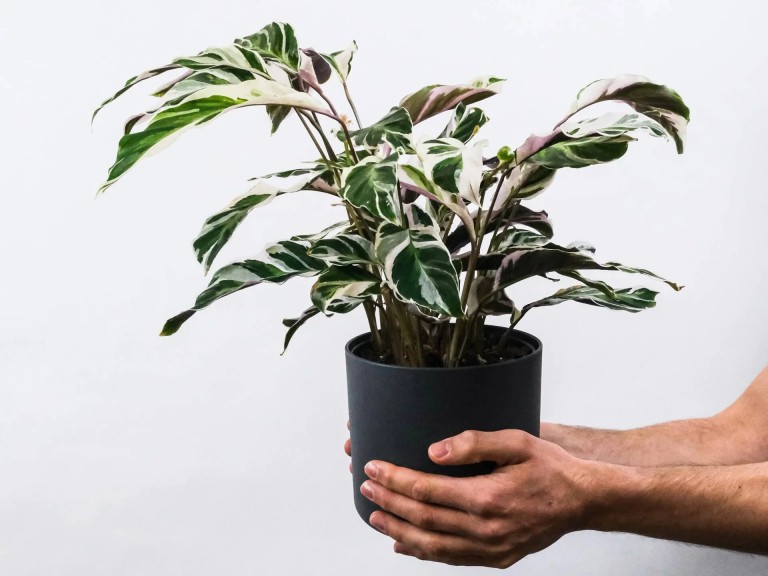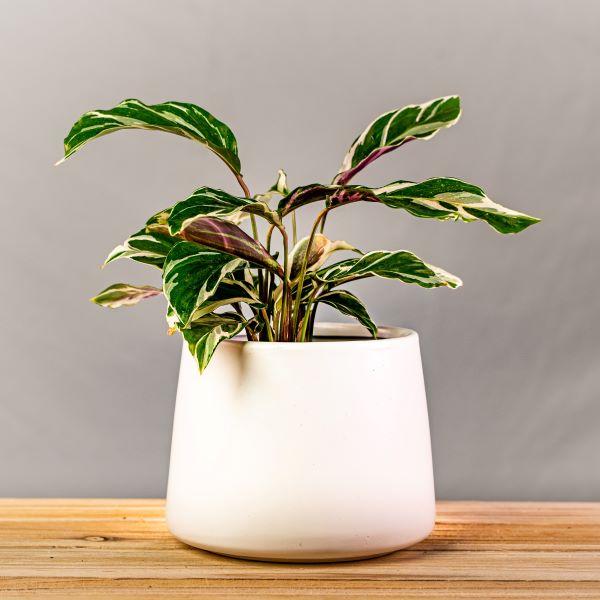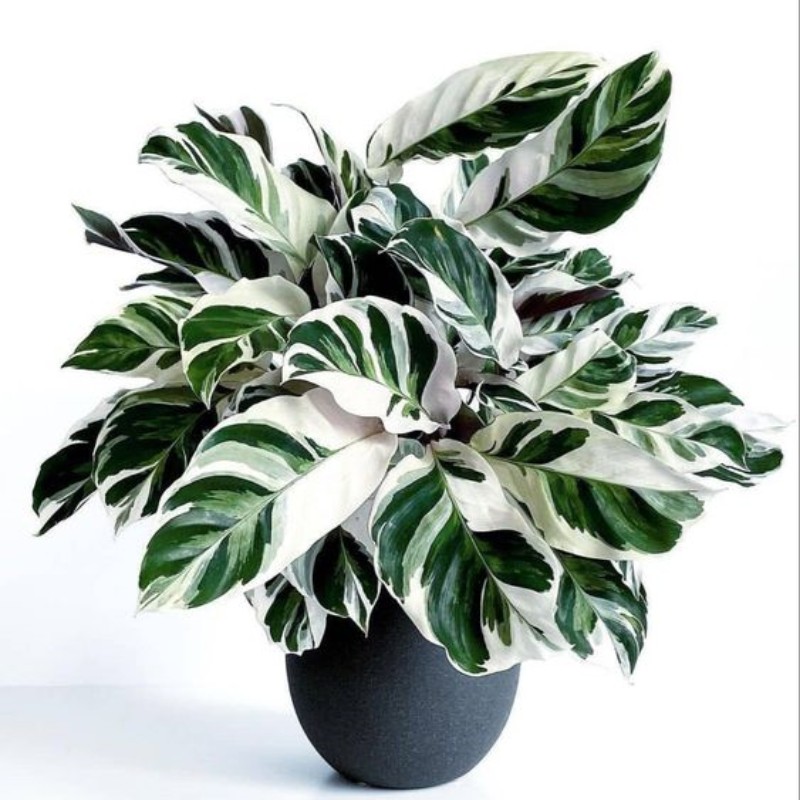Calathea White Fusion is a highly sought-after plant in home gardening thanks to the striking variegation of its foliage. Scientifically known as Calathea little and commonly as peacock plant or prayer plant, it’s native to Central Mexico and South America.
Taiyan Yam discovered the White Fusion cultivar by chance in 2007 in a commercial nursery in Malaysia. Although it hasn’t been around for long and can be picky about its growing conditions, many turn to this plant for a breathtaking touch of nature indoors.
Today, I’m helping you get to know the Calathea White Fusion, from its characteristics to care requirements to benefits, so you can decide if it’s right for you.
Features and Characteristics of Calathea White Fusion
The Calathea White Fusion is the definition of a unique plant, and all it takes is just one glance to know why. Let’s take a closer look at its botanical features and characteristics:
Leaf Shape and Size
The leaves of the Calathea White Fusion are ample with an oval-shaped outline that waves slightly around the edges. Typically, the serrated leaves of the White Fusion cultivar point down.
As for the size of the leaves, they’re pretty large. Each leaf can grow up to 6 inches long and 3 inches wide.
The leaves of a Calathea White Fusion are extremely delicate. Their thinness allows for the passing of light through them, but it also makes them prone to damage if not handled carefully.
When wiping down the leaves to get rid of dust build-up, be sure to do it gently.
Leaf Coloration and Patterns
The foliage of Calathea White Fusion is its show-stopping feature. Its dramatic appearance is the main reason so many plant lovers are trying to get their hands on this particular cultivar.
Each leaf on the Calathea White Fusion shows broad bands of white alternating with dark green strokes. This contrast in variegation offers great dimension to the foliage, but it doesn’t stop there.
The undersides of the leaves are painted in a deep magenta shade that extends down the stems they’re sitting on.
Plant Size and Growth Rate
Despite possessing large leaves, the Calathea White Fusion is pretty compact compared to many of the common houseplants. Its adult size can reach up to 24 inches (2 feet) tall and 18 inches (1 foot) wide.
As such, the Calathea White Fusion has a manageable size that enables you to place it practically anywhere you want around your home or office. Still, certain conditions should be present in the location to deem it suitable for this plant’s growth.
Under proper circumstances, you can expect your Calathea White Fusion to achieve its mature size within a year at a medium growth rate. It’ll stay that size even after repotting.
The lower leaves of the plant grow close to one another while the upper leaves gradually spread out in a graceful arching manner.
Soil and Water Requirements
The Calathea White Fusion does best in moist, well-drained soil with a slightly acidic pH. Watering should be done when the top of the soil is dry or almost dry.
We’ll get into this further in the care section below.
Lighting and Temperature Needs
As a tropical houseplant, the Calathea White Fusion prefers indirect, bright light. It also thrives in warmer temperatures, but not to the point of stifling heat.
Additionally, Calathea White Fusion demands high humidity that mimics its rainforest natural habitat. The following section explains these requirements more thoroughly.
Caring for Calathea White Fusion

The Calathea White Fusion can be quite specific with its growing conditions, which is why beginner plant lovers tend to shy away from owning one.
Yes, caring for Calathea White Fusion is tricky, but it’s very much doable if you take the time to learn it. The key to helping this plant thrive is to recreate an environment similar to its native home in the tropical rainforest.
Here’s a detailed care guide for the Calathea White Fusion:
Soil and Watering Needs
Calathea White Fusion requires soil that can effectively retain moisture without allowing excess water to linger. As such, well-draining, moist soil is the ideal medium for this tropical houseplant.
If the soil retains too much water for too long, the Calathea White Fusion becomes vulnerable to water damage such as root rot.
The soil shouldn’t be too draining though. If it dries up too fast, the plant’s roots won’t have enough time to take up the needed nutrients for growth.
As for the pH, Calathea White Fusion does best in slightly acidic pH (around 6.5).
If you’re buying a potting mix for your Calathea, a soil mix developed for African Violet works great for White Fusion. It’s readily available in most stores and fulfills the draining requirements nicely.
Alternatively, you can make a custom potting mix for your Calathea White Fusion at home. Just combine equal parts of standard potting soil, perlite, and orchid bark.
As for watering requirements, you need to pay attention to the frequency to avoid over-watering and under-watering problems such as root rot and leaves wilting/yellowing.
It’s best not to stick to a schedule for watering Calathea White Fusion. Instead, go by the feel of its soil and water when it dries out.
You can know when watering is due by checking the top of the soil. Dip a finger one inch deep into the soil, if it comes out dry or almost dry then you should water the plant.
In the summer, you’ll probably find yourself watering your White Fusion once a week. But in the winter, the frequency will drop to around once every two weeks as the plant’s growth rate decreases.
When watering, be sure to do it thoroughly and use rain or distilled water. Try to avoid tap water as it contains fluoride and other chemicals that can harm White Fusion.
If you have no choice but to use tap water, leave it in an open container for at least 8 hours before watering. Most of the fluoride/chemicals should’ve dissipated by then.
Fertilizing and Pruning
Calathea White Fusion benefits from fertilization during its growth period; from spring to fall. The plant isn’t a heavy feeder, which explains why a monthly application of fertilizer is more than enough.
A general-purpose fertilizer that’s rich in nitrogen is about everything your White Fusion needs to reward you with lush foliage.
Many plant lovers prefer liquid fertilizer because it’s easy to apply. But slow-release fertilizer granules can be more convenient if you don’t want to stick to a once-per-month application schedule – these can last for the whole growth period.
Another option is adding compost to your Calathea White Fusion soil mix when potting. You shouldn’t need to fertilize until the next repotting.
Be careful not to over-fertilize your White Fusion plant as it can result in root burning. Also, don’t fertilize in the winter as the plant is dormant during the cold season.
When it comes to pruning, the Calathea White Fusion doesn’t ask for much. The plant’s foliage naturally arches out in a graceful form, which saves you a lot of effort on the trimming side.
The only pruning you’ll need to do is cutting dead, old, damaged, or discolored leaves. Not only will this make your White Fusion look healthier and more attractive and promote new growth, but it can also prevent the spread of diseases.
You can repurpose the trimmings in compost or simply throw them out. However, don’t leave them on the surface of the soil.
Lighting and Temperature Requirements

The native habitat of Calathea White Fusion is the tropical rainforest, so its ideal light exposure is bright, indirect (also known as filtered) sunlight.
You don’t need specialized grow lights to achieve these lighting requirements. You just have to know what you’re working with.
If you’re placing the Calathea White Fusion in a room facing north or east, look for a spot next to a window. The sun is gentle yet substantial enough to encourage healthy growth.
If the room is south or west-facing, make sure there’s a sheer curtain between the windows and the plant as direct sun exposure can cause stress and leaf burns.
As for the temperature requirements of a Calathea White Fusion, the ideal range falls between 60 to 70 degrees Fahrenheit (15 to 26 degrees Celsius). This is consistent with the tropical-like conditions you’re trying to mimic for the plant to thrive.
White Fusion can’t handle lower temperatures; anything below 50 degrees Fahrenheit (10 degrees Celsius) will slow its growth and cause foliage discoloration. So be sure to keep your plant away from cool air from fans and air conditioning vents.
You can keep your Calathea White Fusion outside during the summer given that you park it in a shady spot.
Also, keep the plant away from places with temperature fluctuations. For example, a room where the heating is turned on during the day but switched off at night. Another example is nearby doors that often open and close.
Close-knit with temperature is humidity, which is quite elevated in the tropical rainforest. As such, you should keep your Calathea White Fusion in a highly humid environment, ideally between 75 and 85 percent.
Most homes keep humidity at around 30 percent, so here are some tips to increase the humidity of the air surrounding your peacock plant:
- Mist the plant a few times per week
- Group it with other plants
- Place the plant in a pebble tray where the drained water will evaporate over time
- Invest in a humidifier
Pest and Disease Management
Calathea White Fusion prefers moist conditions, so it readily attracts pests such as spider mites, aphids, mealybugs, scales, and fungus gnats.
Applying neem oil can help deter and kill these insects. Spraying the plant with water and insecticidal soap can also get the job done.
The high demand for humidity also makes the Calathea White Fusion prone to fungal or bacterial diseases.
Root rot is a common example of a fungal disease that can strike this plant. In this case, you’ll notice yellowing leaves, mushy/smelly soil, stunted growth, and rotting at the plant’s base.
Dealing with root rot involves:
- Cutting any mushy, brown, or black roots with a sterilized knife
- Washing the pot using warm soapy water
- Replacing the soil with fresh potting mix
- Applying antifungal at the site where you cut the roots
Repotting and Propagation Techniques
Repotting your Calathea White Fusion should be a yearly event or once every two years at max. If you’re not sure if it’s the right time for repotting your plant, you’ll know by observing the leaves and roots.
Are the leaves drooping? Are the roots coming out of the draining holes?
This usually means the soil isn’t enough to retain all of the moisture the plant requires, so adding more soil by increasing the pot size becomes necessary.
Before you transfer your Calathea White Fusion to its new pot, it’s best to use a fresh potting mix. Water thoroughly before and after repotting.
As for propagation, it’s possible with the Calathea White Fusion once it grows big enough. Stem cuttings don’t work for this plant, but thankfully root division does.
Here’s how:
- Water your plant thoroughly a couple of days before propagation.
- On the day of, prepare a new pot and fresh soil mix. Fill about 1/3 of the pot with the soil mix.
- Take the plant out of the pot. You can gently tip the pot to dislodge the plant if it doesn’t come out easily.
- Keep a firm hold on the plant and the root ball, shaking it off gently to remove the soil surrounding the roots.
- Use a clean knife to split your plant along a healthy stem and through the root system separating a few healthy roots.
- Place the separated baby plant in the center of the new pot and top it off with the rest of the soil.
- Place the mother plant back in its pot and press the soil back down.
- With both plants standing upright, water them thoroughly.
- Place the plants in a suitable spot.
The best time for propagating Calathea White Fusion is during spring to avoid transplant shock.
Benefits of Growing Calathea White Fusion
Growing and caring for Calathea White Fusion comes with a load of positive effects, including:
Air Purification
Calathea White Fusion can effectively increase oxygen concentration in the room, lower carbon dioxide levels, and remove toxins such as formaldehyde and benzene.
Adding this plant to your home is a natural way to purify the air indoors. It helps you breathe better-quality air during the day and sleep more comfortably at night.
Aesthetically Pleasing

Calathea White Fusion is a stunning plant, so it serves perfectly as an aesthetic booster.
The contrasting variegation of white and green makes for an intriguing sight, while the purple hues on the underside of leaves and the stems lock in your attention.
Not to mention, being a fairly small size, you can place this plant wherever you like to instantly brighten up any corner.
Low Maintenance
Calathea White Fusion can be a bit fussy with its care requirements at first, but once you establish the plant, maintenance becomes pretty simple.
Non-Toxic to Pets
Calathea White Fusion isn’t just safe for humans, but also pets.
You don’t have to worry about your dog or cat getting poisoned if they ingested some of this plant. The worst that could happen is your pet experiencing a stomach upset.
You need to protect your White Fusion from your pets as the delicate plant is vulnerable to the attacks of sharp teeth and claws.
Boosts Mood and Well-being
The sight of a plant in your house or office can help reduce your stress levels. Having a Calathea White Fusion around can enhance your mood and promote feelings of comfort.
Choosing the Right Calathea White Fusion
If you’re not sure that a Calathea White Fusion is the right plant for you, the following points can help you decide:
Considering Indoor Conditions
Does your home offer a proper environment for the plant?
Is there a spot that receives enough sunlight?
Can it accommodate the suitable temperature and humidity levels for the plant?
Are there children or pets who’ll disturb the plant?
Personal Preferences and Style
Do you like the tropical look of the Calathea White Fusion? Do the bold variations suit your style and decor? Do you prefer something greener or more colorful?
Availability and Price
Is the plant available for purchase where you live? Can you afford it along with the care supplies it requires?
Compatibility with Other Plants
If you have other plants, how does the Calathea White Fusion fit in? Do the other plants also prefer warm temperatures, high humidity, and filtered sunlight?
If not, you’ll have a hard time catering to all the different needs of your plants and one of them will probably end up suffering.
Care Requirements
Finally, do you have what it takes to provide proper care for the plant?
Will you be around to water, fertilize, and prune when needed?
Can you keep track of the temperature and humidity levels surrounding it?
Conclusion
The Calathea White Fusion doesn’t just look fantastic in your home, but it also helps purify the air and improve your mood.
It can be demanding with its growing conditions at first, but caring for it becomes easier with time. The initial effort is very much worth it once your plant thrives.
The key is to simulate an environment close to its native tropical habitat, so be sure to keep the information in today’s guide in your mind as you start your Calathea White Fusion journey.
